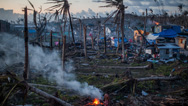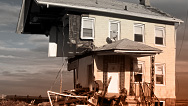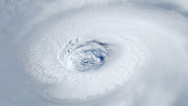The Coriolis Effect
January 9, 2014
NARRATOR: If you've ever watched the news during a hurricane
or wintertime nor'easter, you've probably noticed that big
storms spin over time as they travel. In the Northern
Hemisphere, they spin counterclockwise. But if you were
watching a storm in the Southern Hemisphere, you'd see it
spinning clockwise.
Why do storms spin in different directions depending on
their location? And why do they spin in the first place? A
storm's rotation is due to something called the Coriolis
effect, which is a phenomenon that causes fluids like water
and air to curve as they travel across or above Earth's
surface.
Here's the basic idea: Earth is constantly spinning around
its axis from west to east. But because Earth is a sphere,
and wider in the middle, points at the equator are actually
spinning faster around the axis than points near the poles.
So imagine you were standing in Texas and had a magic paper
airplane that could travel hundreds of miles. If you threw
your airplane directly northward, you might think that it
would land straight north, maybe somewhere in Nebraska.
But Texas is actually spinning around Earth's axis faster
than Nebraska is, because it's closer to the equator. That
means that the paper airplane is spinning faster as well,
and when you throw it, that spinning momentum is conserved.
So, if you threw your paper airplane in a straight line
toward the north, it would land somewhere to the right of
Nebraska—maybe in Delaware. So, from your point of
view in Texas, the plane would have taken a curved path to
the right.
The opposite would happen in the Southern Hemisphere. An
object traveling from the equator to the south would get
deflected to the left.
So, what does this have to do with hurricanes spinning?
Well, at the center of every hurricane is an area of very
low pressure. As a result, the high-pressure air surrounding
the center or "eye" of a storm is constantly rushing toward
the low-pressure void in the middle.
But because of the Coriolis effect, the air rushing toward
the center is deflected off course. In the Northern
Hemisphere the volumes of air on all sides of the eye keep
getting tugged slightly to the right. The air keeps trying
to make its way to the middle, and keeps getting deflected,
causing the entire system to spin in a counterclockwise
direction.
In the Southern Hemisphere, where the Coriolis effect pulls
air to the left, the opposite happens: storms spin around
the eye in a clockwise manner.





